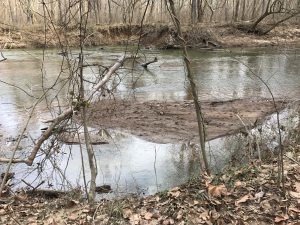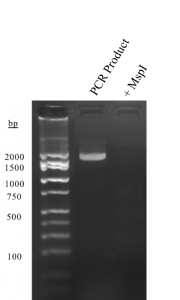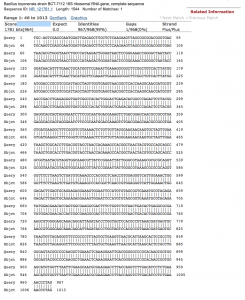Bacillus toyonensis is a cream-colored, matte bacteria found in the soil of the Appomattox River. It has been previously found in probiotics in animal nutrition in Japan (Jiménez, 2013).
References:
- Jiménez G, Urdiain M, Cifuentes A, López-López A, Blanch AR, Tamames J, Kämpfer P, Kolstø AB, Ramón D, Martínez JF. 2013. Description of Bacillus toyonensis sp. nov., a novel species of the Bacillus cereus group, and pairwise genome comparisons of the species of the group by means of ANI calculations. Syst Appl Microbiol 36(6):383-91 doi: 10.1016/j.syapm.2013.04.008.
Date Collected: February 8, 2017
Methods for isolation and identification:
- A soil sample was taken from beneath the water of the Appomattox River (Figure 1). 100μl of the excess water sample was placed on an agar plate and was incubated at 25 degrees Celsius for 48 hours. The plate was parafilmed and placed in the refrigerator for seven days.
- A white, irregular colony (Figure 2) was selected for 16S rRNA gene sequencing by PCR amplification.
- The PCR product was sent for DNA sequencing to identify the species of the bacteria.

Figure 1. Site of collection

Figure 2. Selected colony for identification
Results:
- MspI digestion (Figure 3): A bold band was produced at 2,000 bp by PCR.

Figure 3. Gel electrophoresis results of Appomattox River Soil PCR product and + MSP1.
- DNA Sequence: The sequenced PCR product produced 968 quality base pairs that were used to identify the bacteria as Bacillus toyonensis. The chromatogram of the sequence is available as a pdf (HM02_PREMIX_JF7555_24). NCBI BLAST revealed 99% similarity with 1 gap out of 968 base pairs (Figure 4).

Figure 4. NCBI BLAST results of chosen colony.
Contributed by: Megan Bland and Hannah Hatke, BIOL 250 Spring 2017